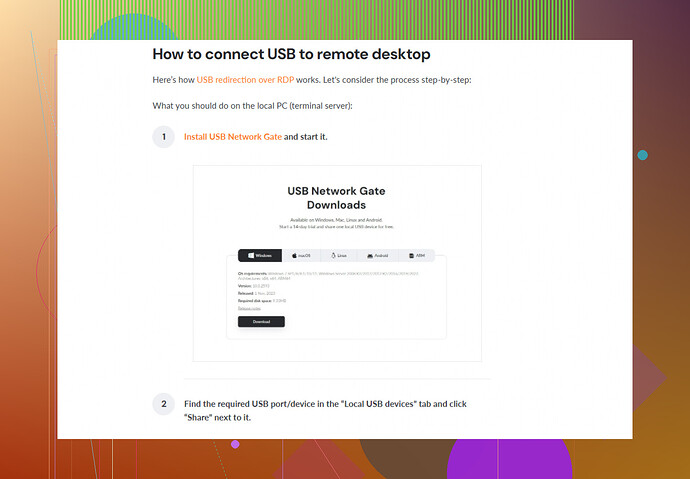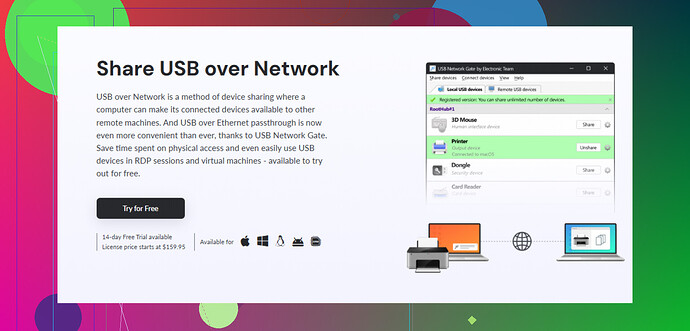I’m struggling to use USB Redirector to access a device on a remote computer. It’s not connecting properly, and I don’t know if it’s a configuration issue or something else. Can someone help troubleshoot this?
When searching for effective tools to manage USB device sharing, there are several noteworthy options available. For example, one resource even lists 5 top USB redirector programs. However, if you’re looking for an efficient and user-friendly solution, I highly recommend giving USB Network Gate a try. This software is particularly praised for its simplicity and compatibility with virtual environments, making it a standout choice.
If you’re tempted to explore free alternatives, be prepared for possible shortcomings—they often require extensive configuration and might not deliver the desired results. On the other hand, hardware-based solutions come with their own set of challenges, primarily limiting you by physical distance.
Considering all these factors, USB Network Gate emerges as the superior choice, offering a seamless experience without the drawbacks associated with free software or hardware limitations.
Before you slam your keyboard in frustration or start contemplating if the USB gods have forsaken you, let’s break this down. If you’re using USB Redirector and it’s being stubborn about connecting, the issue is probably in the configuration or network setup. While @mikeappsreviewer made a solid point about alternatives like exploring top USB redirector tools, let’s troubleshoot what you already have first.
-
Network Issues: Make sure both computers are on the same network, or if you’re working across different networks, check if the proper ports for USB Redirector are open. Firewalls and security software can sneakily block traffic.
-
Driver Problems: The USB device you’re trying to access needs the right drivers installed on both the remote and local machine. Without drivers, it’s like talking to a wall—nothing’s gonna happen.
-
Version Compatibility: Is the version of USB Redirector you’re using outdated? Maybe it’s throwing a tantrum because it doesn’t like the OS on one of your machines. Double-check for updates.
-
Router Config: If port forwarding isn’t set up for remote access, you won’t get anywhere. Dive into your router settings and verify the forwarding rules.
If you’re still stuck after all that, maybe it’s time to throw in the towel on USB Redirector itself. Sure, free tools are nice, but they often come wrapped in headaches like these. Something like USB Network Gate can simplify your life dramatically. It’s super compatible, works smoothly in VMs (which is a big deal if you’re juggling virtual environments), and doesn’t require a PhD in IT to set up.
Now, truth bomb time—no solution is perfect, and I get being cautious about another investment. But in my experience, USB Network Gate has been a way smoother ride than playing whack-a-problem with redirector configs.
Let us know how it pans out, especially if you decide to stick with USB Redirector and manage to fix it—others out there are probably facing the same gremlin.
Have you tried turning it off and on again? Just kidding, sort of. All jokes aside, USB Redirector acting up can be frustrating, but let’s dissect this calmly without tossing your computer out the nearest window.
First off, I’m going to slightly disagree with the others. Sure, alternatives like USB Network Gate are solid (and honestly might save you some hair-pulling), but before jumping ship completely, it’s worth giving USB Redirector another shot—it could just be a small setup wrinkle.
Double-check these basics:
-
Firewalls/Security Software: I cannot stress this enough—your firewall could be the silent killer here. Make sure USB Redirector’s ports aren’t being blocked. Test with your firewall temporarily off (but don’t forget to turn it back on after testing!).
-
IP Address Accuracy: Is the remote computer’s IP address correct? Mistyped IPs happen way too often, especially if DHCP is enabled and the address changes occasionally.
-
Correct USB Device Sharing: Did you actually share the USB device on the remote computer through the USB Redirector app? It might sound obvious, but we’ve all been there, assuming we configured something when we didn’t.
-
Software Version Mismatch: Is the USB Redirector’s version consistent across both the sending and receiving machines? Older versions can clash with newer OS updates, creating headaches.
Now, let’s jump to the wild card: Network Location. If the computers aren’t on the same local network, then you HAVE to deal with port forwarding on your router. It’s not always fun (or easy), but without it, the connection simply won’t establish on external networks.
That said, and I hate to say it, sometimes free tools just don’t cut it in terms of reliability and ease of use. If you’ve banged your head on this for hours with no progress, maybe it’s time to explore something like USB Network Gate, which is literally built to avoid these configuration nightmares. It even plays nicely with virtual machines and remote environments. You can check out their hassle-free USB sharing software if nothing seems to work.
One last thing—if this is a USB hub you’re working with, sometimes the issue is with the hub itself, not the software. Switching to direct USB attachment can help rule out bad hardware.
Good luck busting those gremlins—keep us in the loop on what works (or doesn’t)!
Let’s cut through the noise here—sometimes troubleshooting USB Redirector can feel like untangling a set of earphones, but hang tight because there are a few less-explored angles you could check out before throwing in the towel or switching software.
First, connectivity gremlins often lurk in these unexpected areas:
-
Device Power and Compatibility: Is your USB device 100% compatible with remote access tools? Some specialized devices (like industrial sensors or dongles) can behave unpredictably in virtual environments. Even high-power USB devices might not function properly if they aren’t receiving sufficient power remotely.
-
Driver Conflicts: Check if specific drivers for your USB device are installed on both systems. USB redirector software depends heavily on proper driver communication. Without identical driver setups for both local and remote machines, the system can get stuck in a never-ending handshake loop without actually connecting.
-
Bandwidth Bottleneck: USB devices like cameras or external drives often chew up a good chunk of network bandwidth. If this is your case, make sure your connection isn’t throttled or choked by other apps hogging the network (hello, heavy downloads and video streaming!).
Now, let’s put USB Network Gate on the radar for a moment. From what I’ve seen and experienced, it has two standout pros: it’s ridiculously simple to get running, and it plays SO well with virtualized setups like VMware or Citrix. However—and this is a big one—it’s not free, and the price point can be a dealbreaker if all you’re doing is occasional tinkering or small-scale projects. Reliability comes with a price, though, and USB Network Gate nails it there compared to USB Redirector if you’ve got gnarly setup roadblocks.
On the flip side, alternatives aren’t totally irrelevant. The original USB Redirector holds its ground if you’re patient with manual configuration, and yes, there’s also FabulaTech’s USB over Network—the latter sits snugly between user-friendliness and reliability, striking a decent balance. Just don’t expect hand-holding from free apps in this arena; technical know-how often becomes your Plan B.
One argument for sticking with USB Redirector: it’s robust for specific low-latency tasks, particularly for users familiar with the interface. If the issue is firewall/port forwarding or IP-related, it’s totally fixable—just takes time.
Final note—skip any direct blame on your PC or network right now. Test on a second device, or grab a friend’s computer to rule out something quirky like an old version mismatch. And if USB Network Gate feels like a better upgrade path after all this? Fair play—you’ll save yourself this repetitive troubleshooting loop in the long run.

